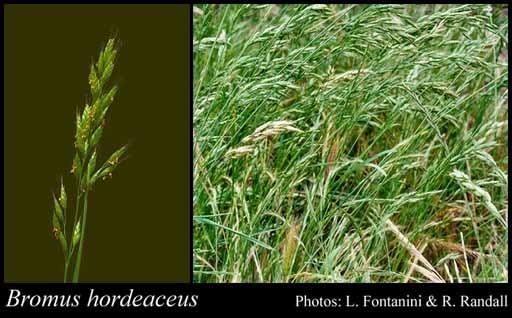- Reference
- Sp.Pl. [Linnaeus] 1:77 (1753)
- Conservation Code
- Not threatened
- Naturalised Status
- Alien to Western Australia
- Name Status
- Current
Tufted annual, grass-like or herb, 0.1-0.4 m high. Fl. green, Aug to Nov. Calcareous loam, sand, black sandy clay.

Distribution
- IBRA Regions
- Avon Wheatbelt, Coolgardie, Esperance Plains, Geraldton Sandplains, Jarrah Forest, Mallee, Swan Coastal Plain, Warren.
- IBRA Subregions
- Eastern Mallee, Fitzgerald, Geraldton Hills, Katanning, Lesueur Sandplain, Mardabilla, Merredin, Northern Jarrah Forest, Perth, Recherche, Southern Jarrah Forest, Warren, Western Mallee.
- IMCRA Regions
- Abrolhos Islands, Leeuwin-Naturaliste, WA South Coast.
- Local Government Areas (LGAs)
- Albany, Augusta Margaret River, Bayswater, Beverley, Boyup Brook, Bridgetown-Greenbushes, Busselton, Cockburn, Collie, Coorow, Dandaragan, Dardanup, Denmark, Donnybrook-Balingup, Esperance, Gnowangerup, Goomalling, Gosnells, Greater Geraldton, Harvey, Jerramungup, Kalamunda, Kojonup, Kwinana, Mandurah, Manjimup, Mingenew, Mundaring, Murray, Narrogin, Nedlands, Northam, Perth, Plantagenet, Ravensthorpe, Rockingham, Serpentine-Jarrahdale, South Perth, Swan, Wagin, Wanneroo, Waroona, West Arthur, Wickepin, Woodanilling, York.
Management Notes (for the Swan NRM Region)
Alternative Names. Soft chess, soft brome.
General Biology. Growth form. Grass. Life form. Annual, caespitose. Reproduction. Seed. Dispersal. Mammals, wind. Photosynthetic Pathway. C3. Seedbank persistence. Short, days to 1 year. Fire response. Fire creates suitable conditions for mass germination of seed. Seeds are only damaged in very hot fires.
Notes. Similar to the native Bromus arenarius (sand brome) which has an earlier flowering period of July to Ocotober. Germination is slightly inhibited by light. Viable seeds germinate in their first autumn, limited seed is carried over from year to year in the seedbank. Seeds shed approximately one month after ripening.
Additional information. Origin. Macronesia, northern Africa, western temperate Asia, southwestern and eastern Europe. History of use/introduction. Cattle fodder. Similar native species. Bromus arenarius.
Suggested method of management and control. Prevent seed set. Hand pull, or in degraded areas use 1% glyphosate on seedlings, young plants or when flowering. Alternatively spray plants at 3-5 leaf stage with Fusilade® Forte at 16 ml/10 L or 800 ml/ha (based on 500 L water/ha) + wetting agent or for generic fluazifop-p (212g/L active ingredient) 10ml/10L or 500ml/ha + wetting agent. Repeat the following year if required. An early and late application may be required where two Bromus species are present. Read the manufacturers' labels and material safety data sheets before using herbicides. For further information consult the Australian Pesticides and Veterinary Medicines Authority to determine the status of permits for your situation or state.
Management Calendar
| Calendar Type | Jan | Feb | Mar | Apr | May | Jun | Jul | Aug | Sep | Oct | Nov | Dec | Comments |
|---|---|---|---|---|---|---|---|---|---|---|---|---|---|
| Active Growth | O | Y | Y | Y | Y | Y | |||||||
| Germination | O | Y | Y | ||||||||||
| Flowering | Y | Y | Y | ||||||||||
| Fruiting | O | Y | Y | ||||||||||
| Optimum Treatment | Y | Y | Y | O | O |
Legend: Y = Yes, regularly, O = Occasionally, U = Uncertain, referred by others but not confirmed.
References
- Andersson, L., Milberg, P., Schults, W. & Steinmetz, O. (2002) Germination characteristics and emergence time of annual Bromus species of differing weediness in Sweden. Weed research, 42 (2): 135-147.
- Brown, K. & Brooks, K. (2002) Bushland Weeds: A Practical Guide to their Management. Environmental Weeds Action Network, Greenwood.
- Carr, G.W., Yugovic, J.V. & Robinson, K.E. (1992) Environmental weed invasions in Victoria. Department of Conservation and Environment, Melbourne.
- DiTomaso, J.M., Brooks, M.L., Allen, E.B., Minnich, R., Rice, P.M. and Kyser, G.B. (2006) Control of invasive weeds with prescribed burning. Weed Technology, 20 (2): 535-548.
- Howard, J. (1998) Bromus hordeaceus. In: Fire Effects Information System, [Online]. U.S. Department of Agriculture, Forest Service, Rocky Mountain Research Station, Fire Sciences Laboratory (Producer). URL: http://www.fs.fed.us/database/feis/ - Accessed December 2009.
- Hussey, B.M.J., Keighery, G.J., Dodd, J., Lloyd, S.G. & Cousens, R.D. (2007) Western Weeds. A guide to the weeds of Western Australia. 2nd Edition. The Plant Protection Society of Western Australia, Victoria Park.
- Moore, J.H. & Wheeler, J. (2008) Southern weeds and their control. DAFWA Bulletin 4744.
- USDA, ARS, National Genetic Resources Program (2009) Germplasm Resources Information Network - (GRIN). National Germplasm Resources Laboratory, Beltsville, Maryland. URL: https://npgsweb.ars-grin.gov/gringlobal/taxon/taxonomysimple.aspx - Accessed October 2009.